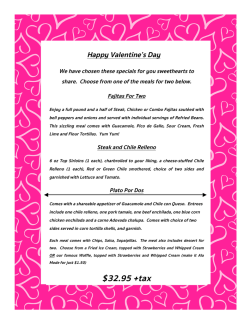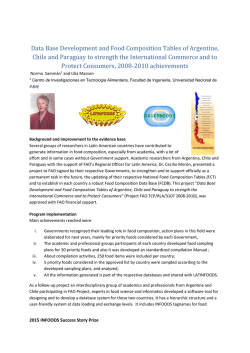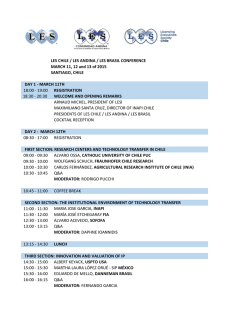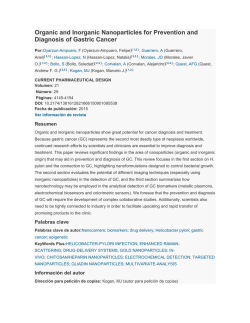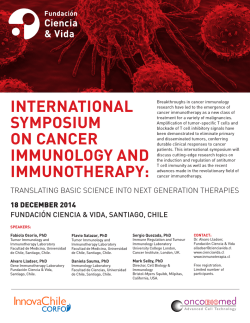
Official tentative Program on line - ICMSS 2015 – 10th International
Tentative program on line. January 2015 www.icmss2015.com Sunday, March 15 Registration Hotel Patagónico Puerto Varas Chile Registration Poster set up full conference 15:00-18:00 Stand set up full conference Operture. Lugar a confirmar Place to be confirmed (TBC) Welcome ICMSS 2015: Viviana Cachicas Welcome by Regional & National Chilean Authorities Welcome main sponsors & reference organizations Remembering ICMSS 2013 Anthony Zammit Special Award for participating in the conference since 1994 19:00-21:00 Monday , March 16 Magistral Conference Climate change: What about Latin America influence?? Marcelo Mena PhD. Ex- Director Center for Sustainability Research at Universidad Andres Bello Chile & Under Minister of the Environment of Chile 2014. Break & Posters official presentation 09:00-10:00 10:00-10:30 Simposio N° 1 : Shellfish and Environment Chair: Anthony Zammit Global change and its effect in human Health. Steve Jones UNH-US. Growth of Bacteria in Shellfish and the emergence of seafood related outbreaks. Romilio Espejo. Omics-Chile ISA virus in Chile: Coexisting Shellfish and Salmon farms. Marco Godoy ETECMA Chile. 10:30 -12:30 Lunch 12.30 -14 h Biotoxin & Phytoplankton Session: Management and surveillance Day Chair: Claudia Rozas. Parallele session N° 1 : Oral Sessions & Round Tables I- HAB monitoring 1. Leonardo Guzmán, IFOP, Chile : Something is happening in fjords and channels of Southern Chile (41° 55°): the case of Alexandrium catenella and Paralytic Shellfish Poison for the past 40 years. 2. B. Roughan, New Zealand: Mussel long-line culture and the risks of toxic Dinophysis in the water column. 3. Joe Silke, Ireland: Operational Forecasting of Harmful Algal Blooms and Toxicity in Ireland Virus Virus Round table N° 1: Chair: Soizick LeGuyader Impact of NpV infection .An overview including Chilean data. Miguel O Ryan U Chile A Characterization of outbreaks associated with NoV in Chile. /Viviana Cachicas ISP-Chile. Male coli phage relevance for Interstate Shellfish Sanitation Conference. Ken Moore ISSC US. (TBC) Norovirus persistence in oysters after accidental contamination. Soizick Le Guyader LSEM/SG2M IFREMER France. 14:00-18:00 Break 16:00:16:30 II- Biotoxins monitoring: 1. Mario Castillo, COFEPRIS, México: The Red Tide Project as a health monitoring system for the shellfish exposed to Harmful Algal Blooms (HABs) 2. Mathias Schramm, Brazil: Occurrence of phycotoxins in the coast of Santa Catarina, the largest aquaculture mollusks producer in Brazil. 3. R. Biré, France: Review of three years of monitoring of palytoxin-group toxins in different marine organisms in Villefranche bay on the French Mediterranean coast 4. Renyan Liu, China: The problems and countermeasures of marine molluscan shellfish safety in China. 5. Grace Mellano, Canada: Communicating with stakeholders: new tools to meet challenges 6. Ulyses Montojo, Philippines: Detection of possible ciguatera and ciguatera-like toxins in five genera of reef fishes from West Philippines and Sulu Seas. 7. Malin Persson, Sweden: Risk Assessment and Risk mapping. Getting the most out of sanitary surveys. Michelle Price Hayward. Cefas UK. Investigation of Norovirus Viability. Kingsley, D. Ag Res service, Virologist, USDA Oral Presentations: Chair: Jesus Romalde Evaluation of the characteristics of the wastewater treatment plants for the microbial contamination of bivalve molluscs production areas in the Italian mid-Adriatic coast. Latini, M. Centro di Referenza Nazionale Ancona Italy Assessment of norovirus persistence in shellfish harvesting areas: management of health risks in Sardinia region . Ricardo Bazzardi.Intiitute of the Sardinia. Italy. A dynamic model of norovirus outbreaks accounting for inter-human transmission and consumption of contaminated oysters: application for shellfish management in coastal The first well documented event of Paralytic Shellfish Toxins (PST) in blue mussels (Mytilus edulis) in Sweden areas THEBAULT, A1. 1Risk Assessment Department ANSES. France 8. Peter Whelan, Ireland: Food Fraud - Can I open my bay for harvesting of mussels by switching my sample with mussels from an already open bay? Workshop n°1 Fluorometry of High Repetition FRRF= Applied to photosynthetic cells of dinoflagellates/Fluorometria de altas tasas de repetición FRRF3 aplicado a células fotosintéticas de dinoflagelados. .Laboratorio Plancton Andino. Puerto Varas. Chile. Coordinador : Lorena Delgado Lab Biotoxinas ISP Chile 18:15 -21h Tuesday , March 17 Simposio N° 2 : Genomic of shellfish Chair: Enrico Buenaventura Academic collaboration for trazeability to shellfish producers . Marcela Astorga PhD. University Austral de Valdivia Chile 9:00:10:30 Molecular traceability in Chilean blue mussel. Genomic tools to enforce food quality and safety. M Angélica Larrain University of Chile Metagenomics for pathogen detection in Shellfish. Romilio Espejo. OmicsChile. Breakl & Posters Biotoxin & Phytoplankton Virus Day Chair: Leonardo Guzman Day Chair: Michelle Price Hayward I- Analytical methods: perspectives and challenges Parallele session N°2: Oral presentation & Round Tables. 10:30 -11:00 1) Begoña Ben-Gigirey, EURLMB, Spain: The transition from mouse bioassay to chemical methods for the determination of saxitoxin group toxins: the EURLMB experience. 2) Tim Harwood, Cawthron Institute, New Zealand: Single laboratory validation of a UPLC-HILIC-MS/MS method for quantitation of paralytic shellfish toxins in twelve commercially produced bivalve shellfish species 3) Arjen Gerssen, Rikilt, Holland: Assessing the impact of risk management procedures on norovirus concentrations in oysters at a production site over a three year period. Dore, B. Shellfish Safety Marine Institute. Irland Norovirus detection in oysters: the effect of sample size on the precision of production site virus concentration estimates. Hunt, Kevin. Shellfish Microbiology Unit, , Marine Institute. Irland Impact of oysters in refinement in claires on virus elimination. LoisyHamon, F1 1R&D Ceeram France- 11:00-18:00 Break 16: 00-16:30 Screening of a wide variety of fycotoxins in different matrices using liquid chromatography high resolution mass spectrometry 4) Beatriz San Martin, Universidad de Chile : MARINE LIPOPHILIC TOXINS; From the bioassay to LC-MS / MS II- Alternative technologies for biotoxins detection 1) Andrew Turner, Cefas, United Kingdom: An update on the use of alternative testing methodologies for marine biotoxins in Latin American Shellfish 2) David Cassis, Jellet, Chile: Volunteer-based harmful algae monitoring networks with rapid toxin detection as an added safety layer and managing option for aquaculture. 3) Marcia Bodero, Rikilt, Holland: Mode of action-based bioassays for marine biotoxins causing gastrointestinal disturbances 4) K. Melville, Neogen, United Kingdom: Detection and quantification of saporovirus in bivalve molluscs from harcesting areas in Galicia (New spain) Jesús Romalde U Santiago de Compostela España. Tulane virus: a surrogate to study norovirus behavior in oyster? Le Guyader, Soizick. 1Laboratoire de Microbiologie LSEM Occurrence of bacterial and viral enteric pathogens and marine bacteria and discrimination of faecal sources in shellfishharvesting areas and their catchments in France. Gourmelon, M. 1LSEM-SG2M-RBE Ifremer Université de Caen, France Development and validation of a range of lateral flow immunoassays for the rapid screening of marine biotoxins (ASP, DSP, PSP) in shellfish 5) J. Nicolas, Rikilt, Holland: High throughput assays for sensitive screening of marine neurotoxins in seafood 6) Bovee, Toine Rikilt Wageningen. Netherlands (Holland): Cell based bioassays for the detection of marine toxins in fish and shellfish for replacing animal testing.. Workshop N ° 2: Seremi Laboratory Technologic tour N ° 1: Shellfish and Industry Farm. Detection kit for Biotoxins. David Cassis Jelllet Co. Chair : Cristina Hernandez Laboratorio Seremi Región de Los Lagos Lorena Delgado ISP Chile MEJILLONES AMERICA SA PLANTA DE PROCESO . Chair: Gonzalo Diaz, Food Inspector Seremi Salud Región de Los Lagos Chile & Monica Jara Food Microbiology ISP-Chile 18:15 -21:00h 16:00-21:00 Wesneyday, March 18 Round Table : International practices in Bivalves sanitation programme Chair Iddya Karunasagar 9: 00 -10:30 h Introduction to FAO/WHO work on Technical Guidelines on bivalve. Technical Guideline of Codex Code of Practice for Fish and Fishery Products. Iddya Karunasagar Fish &Fishery Office FAO. Iddya Karunasagar: Iddya Karunasagar, FAO. Global bivalve production and issues related to international trade Current statud of dradt Guidelines : Brian Roughan NZ Challenges in the implementation of the programme - Representative from Asia - Representative from Africa - Representative from America Comments by Ron Lee CEFAS UK Break & Posters CONFERENCE Parallele session N° 3 : Oral presentation & Round Tables. 10:30-11:00 How FDA validated their criteria for sewage treatment plant discharges? Gregory Goblick. Shellfish and Aquaculture Policy Branch US FDA. / Biotoxin & Phytoplankton Bacterial & Virus. Day Chair: Lorena Delgao Day Chair: Jose Barreiro 11:00-11:30 11:30-18:00 Break 16: 00-16:30 I- Risk Assessment and Emerging marine biotoxins Vibrios Round Table N 2 : Were we are ? 1) N. Arnich, France: Overview of recent works of ANSES (the French food safety agency) on marine biotoxins (lipophilic phycotoxins monitoring in shellfish, ciguatoxins in shark, seawater treatment) Long term of pathogenic VIBRIO SPP. Population in New England U.S. Stephen H. Jones. Northeast Center for Vibrio Disease and Ecology, University of New Hampshire US. 2) Andrew Turner, Cefas, United Kingdom: Is tetrodotoxin a risk to consumers of European bivalve molluscs? The Mexican Shellfish Sanitation Program (PMSMB) and the sanitary control of the Vibrio parahaemolyticus. Jose Barreiro COFEPRIS. México. 3) Alison Turnbull, South Australian Research and Development Institute, Australia: Marine biotoxin risk assessment of Australian wild-caught abalone Risk Management of Vibrio parahaemolyticus in Oysters in Canada from 1997-2014. Buenaventura, Enrico. Food Inspection Agency. Canada. II- Biotoxin uptake & elimination dynamics 1) Allan Cembella, Alfred-WegenerInstitut, Germany: Temperature effects on kinetics of paralytic shellfish toxin elimination in the Atlantic surfclam Spisula solidissima Predictive bases of Vibrio parahaemolyticus in shellfish using Air and Water Temperature for Public Health management and production. Viviana Cachicas. ISP Chile . Oral presentation: Vibrio parahaemolyticus and fecal pollution in zones of bivalve mollusks at the Mediterranean coast of Egypt. El-Shenawy, Moustaf. National Research Cente. Egypt. Evolution of the pandemic strain of Vibrio parahaemolyticus in the Chilean coast. Katherine Garcia. , Katherine. Universidad Autónoma de Chile . A miniaturized MPN real-time PCR method for rapid quantification of total and enteropathogenic Vibrio parahaemolyticus in shellfish. HERVIOHEATH, Dominique. Ifremer, France. Vibrio outbreaks in the Philippines 1988-2012. Vinarao, Reivin. 1Department of Agriculture, National Fisheries Research and Development Institute, Post Harvest Research and Development Division, Chemical and Microbiological Section, Corporate 101 Mother Ignacia Avenue, 1102 Quezon City, Philippines JORNADA REGULATORIA JUEVES , Marzo 19 9:00 -13:30 Moderador: Cristina Martinez ISP /Claudia Rozas Sernapesca Chile MESA REDONDA SESIÓN REGULATORIA. EXPERIENCIA CHILENA EN PRODUCCIÓN , CONSUMO Y EXPORTACIÓN Programa de Vigilancia ambiental y seguridad alimentaria en Chile. Lorena Rodriguez. Ministerio de Salud Chile Consumo y vigilancia regional de moluscos. Eugenia Schanake. Seremi de Salud Los Lagos. Acuícultura en pequeña escala . Jose Miguel Burgos. Director Sernapesca Chile Experiencia en Codex y Biotoxinas. Cecilia Solis Sernapesca Chile 9:00 -11:00 Break & Posters 11:00-12:00 La ley de modernización de la inocuidad Alimentaria. Desafios para las exportaciones de alimentos a los EEUU. CONFERENCIA 1 SESSIÓN REGULATORIA Julio Salazar. Subdirector de la FDA para América Latina. Gonzalo Ibañez. Analista Internacional de la FDA. Oficina Santiago de Chile Cierre de Sesión Regulatorias: Marisa Caipo Ofificial FAO Latin America. 13: 00-13:15. 13:15-15:00 Lunch CLOSURE 12:00 A 13:15 ICMSS 2017 proposal Poster Award IAC conclusions of the conference. 15:00 -17:00 Friday , March 19 Workshop N° 3 Day Centro Experimental Universidad de Los Lagos. Technologic Tour N° 2: shellfish farm & processing plant Orizon SA. Km 12.5 camino a Chinquihue Puerto Montt Dye tracing studies in shellfarm areas, Gregory Goblick US FDA Shellfish and Aquaculture Policy Branch. Chair : Carlos Aranda i-Mar Universidad de Los Lagos. Shellfish Farm and Calbuco area. Chair : Gonzalo Diaz Seremi Salud Región de Los Lagos Chile Mónica Jara ISP Chile. 9:00-15:00 9:00 -15:00 Poster performance in full conference at morning breaks: The presenters will be at morning coffees breaks at least two days, specially Monday and Thrusday March 19 / Los poster pueden permanecer durante toda la conferencia y ser presentados por lo menos dos mañanas en los intermedios de preferencia el dia Lunes y Jueves. El comité científico internacional eligirá el mejor/ IAC will elect best for award. Poster N°1 EVALUATION OF THE POSSIBLE SOURCE OF DISCREPANCY IN THE RESULTS OBTAINED AFTER THE APPLICATION OF MBA AND LC-MS/MS FOR THE Ben-Gigirey, ANALYSIS OF LIPOPHILIC TOXINS Poster N°2 Poster N°3 A VALIDATED PP2A METHOD- OKATEST-ADAPTED FOR DETERMINATION OF LIPOPHILIC TOXINS IN COMBINATION WITH LC-MS/MS Biotoxins monitoring program in Brazil Modelling the spatial and temporal dynamics of paralytic shellfish toxins at different scales: implications for research and management Poster N°4 a Marine toxins: new technologies and their impact in mussel farming. Poster N°4 b Alexandrium catenella cysts in Southern Chile: An overview of fifteen years of studies Poster N°4 c Poster N°5 Development of a probabilistic risk assessment approach to set the baseline for the comparison of different monitoring/management strategies for PSP BEuropean Union Reference Laboratory for Marine Biotoxins (EURLMB) Dominguez Perez Elena ZEULAB S.L.España Schramm, Mathias Seguel, Miriam. Centro Regional de Análisis de Recursos y Medio Ambiente Universidad Austral de Chile Myrriam Seguel. Centro Regional de Análisis de Recursos y Medio Ambiente Universidad Austral de Chile. Seguel, Miriam. Centro Regional de Análisis de Recursos y Medio Ambiente Universidad Austral de Chile Thebault, A ANSES French Agency for contaminated shellfish The potential of temperature shock treatment to control the growth of Vibrio parahaemolyticus and Vibrio cholerae in Philippine shell stock oysters Poster N°6 Poster N°7 Poster N°8 Poster N°9 Poster N°10 Norovirus from environment samples associated to outbreaks in Chile 20102014 Analysis of Vibrio parahamolyticus MAM-7 gene polymorphism by RFLP: Proof of concept of a potential pathogenicity gene marker Characterization of Vibrio parahaemolyticus in bivalve molluscs from the coast of Buenos Aires, Argentina using pulsed-field gel electrophoresis (PFGE) Presence of Arcobacter spp. in bivalve molluscs from harvesting areas of the Central Adriatic Sea, Italy Food, Environmental and Occupational Health & Safety Vinarao, Reivin. 1Department of Agriculture, National Fisheries Research and Development Institute, Post Harvest Research and Development Division, Chemical and Microbiological Section, Corporate Philippine Monica Jara. Food Microibiology ISP Chile Esquivel Allende, M.J Jurquiza, V INIDEP Argentina F Leoni Sezione di Ancona Istituto Zooprofilattico Sperimentale dell´Umbria e delle Norovirus prevalence in Dutch production area with Class A/B classification. Poster N°11 Heavy Metals in seafood from Chilean Coast in 2013-2014 Poster N°12 Marche Pol-Hofstad, Irene. Laboratory for Zoonoses and Environmental Microbiology RIVM. Ramírez Jaminton A Química de Alimentos. ISP Chile
© Copyright 2024
